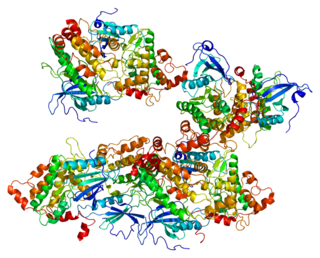Death-associated protein kinase 1 is an enzyme that in humans is encoded by the DAPK1 gene. [5]
Death-associated protein kinase 1 is an enzyme that in humans is encoded by the DAPK1 gene. [5]
Death-associated protein kinase 1 is a positive mediator of gamma-interferon induced programmed cell death. DAPK1 encodes a structurally unique 160-kD calmodulin dependent serine-threonine kinase that carries 8 ankyrin repeats and 2 putative P-loop consensus sites. It is a tumor suppressor candidate. [6]
In melanocytic cells DAPK1 gene expression may be regulated by MITF. [7]
Depletion of DAPK1 results in inhibition of tumor cell count and volume growth in cellular and animal models of triple receptor-negative breast cancer, from individuals with p53-mutant cancers. [8] This has not been demonstrated in actual patients.

ATM serine/threonine kinase or Ataxia-telangiectasia mutated, symbol ATM, is a serine/threonine protein kinase that is recruited and activated by DNA double-strand breaks, oxidative stress, topoisomerase cleavage complexes, splicing intermediates, R-loops and in some cases by single-strand DNA breaks. It phosphorylates several key proteins that initiate activation of the DNA damage checkpoint, leading to cell cycle arrest, DNA repair or apoptosis. Several of these targets, including p53, CHK2, BRCA1, NBS1 and H2AX are tumor suppressors.

Mitogen-activated protein kinase 9 is an enzyme that in humans is encoded by the MAPK9 gene.

Transcription factor Jun is a protein that in humans is encoded by the JUN gene. c-Jun, in combination with protein c-Fos, forms the AP-1 early response transcription factor. It was first identified as the Fos-binding protein p39 and only later rediscovered as the product of the JUN gene. c-jun was the first oncogenic transcription factor discovered. The proto-oncogene c-Jun is the cellular homolog of the viral oncoprotein v-jun. The viral homolog v-jun was discovered in avian sarcoma virus 17 and was named for ju-nana, the Japanese word for 17. The human JUN encodes a protein that is highly similar to the viral protein, which interacts directly with specific target DNA sequences to regulate gene expression. This gene is intronless and is mapped to 1p32-p31, a chromosomal region involved in both translocations and deletions in human malignancies.

Apoptosis signal-regulating kinase 1 (ASK1) also known as mitogen-activated protein kinase 5 (MAP3K5) is a member of MAP kinase family and as such a part of mitogen-activated protein kinase pathway. It activates c-Jun N-terminal kinase (JNK) and p38 mitogen-activated protein kinases in a Raf-independent fashion in response to an array of stresses such as oxidative stress, endoplasmic reticulum stress and calcium influx. ASK1 has been found to be involved in cancer, diabetes, rheumatoid arthritis, cardiovascular and neurodegenerative diseases.

Protein kinase C delta type is an enzyme that in humans is encoded by the PRKCD gene.

Ras association domain-containing protein 1 is a protein that in humans is encoded by the RASSF1 gene.

Serine/threonine-protein kinase PAK 2 is an enzyme that in humans is encoded by the PAK2 gene.

Baculoviral IAP repeat-containing protein 2 is a protein that in humans is encoded by the BIRC2 gene.

PRKC apoptosis WT1 regulator protein, or Prostate apoptosis response-4, is a tumor-suppressor protein coded for in the human by the PAWR gene, that induces apoptosis in cancer cells, but not in normal cells.

Serine/threonine-protein kinase 4 is an enzyme that in humans is encoded by the STK4 gene.

DnaJ homolog subfamily A member 3, mitochondrial, also known as Tumorous imaginal disc 1 (TID1), is a protein that in humans is encoded by the DNAJA3 gene on chromosome 16. This protein belongs to the DNAJ/Hsp40 protein family, which is known for binding and activating Hsp70 chaperone proteins to perform protein folding, degradation, and complex assembly. As a mitochondrial protein, it is involved in maintaining membrane potential and mitochondrial DNA (mtDNA) integrity, as well as cellular processes such as cell movement, growth, and death. Furthermore, it is associated with a broad range of diseases, including neurodegenerative diseases, inflammatory diseases, and cancers.

Growth arrest and DNA-damage-inducible protein GADD45 gamma is a protein that in humans is encoded by the GADD45G gene on chromosome 9. GADD45G is also known as CR6, DDIT2, GRP17, OIG37, and GADD45gamma. GADD45G is involved in several different processes, including sexual development, human-specific brain development, tumor suppression, and the cellular stress response. GADD45G interacts with several other proteins that are involved in DNA repair, cell cycle control, apoptosis, and senescence. Low expression of GADD45G has been associated with many types of cancer.

Interferon regulatory factor 8 (IRF8) also known as interferon consensus sequence-binding protein (ICSBP), is a protein that in humans is encoded by the IRF8 gene. IRF8 is a transcription factor that plays critical roles in the regulation of lineage commitment and in myeloid cell maturation including the decision for a common myeloid progenitor (CMP) to differentiate into a monocyte precursor cell.

28S ribosomal protein S29, mitochondrial, also known as death-associated protein 3 (DAP3), is a protein that in humans is encoded by the DAP3 gene on chromosome 1. This gene encodes a 28S subunit protein of the mitochondrial ribosome (mitoribosome) and plays key roles in translation, cellular respiration, and apoptosis. Moreover, DAP3 is associated with cancer development, but has been observed to aid some cancers while suppressing others.

Death-associated protein kinase 3 is an enzyme that in humans is encoded by the DAPK3 gene.

E3 ubiquitin-protein ligase MIB1 is an enzyme that in humans is encoded by the MIB1 gene. It is involved in regulating apoptosis.

Death-associated protein kinase 2 is an enzyme that in humans is encoded by the DAPK2 gene.

Netrin receptor UNC5A is a protein that in humans is encoded by the UNC5A gene.

Death-associated protein 1 is a protein that in humans is encoded by the DAP gene.

Serine/threonine kinase 17a is a protein that in humans is encoded by the STK17A gene.